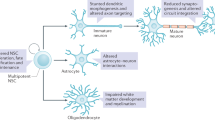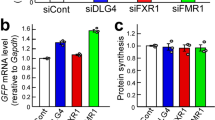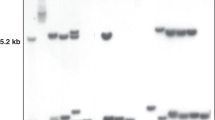Abstract
We have performed mRNA in situ hybridization studies and northern blot analysis in the mouse and human, respectively, to determine the normal gene expression patterns of FMR–1. Expression in the adult mouse was localized to several regions of the brain and the tubules of the testes, which are two of the major organs affected in fragile X syndrome. Universal and very strong expression was observed in early mouse embryos, with differentially decreasing expression during subsequent stages of embryonic development. The early embryonic onset and tissue specificity of FMR–1 gene expression is consistent with involvement in the fragile X phenotype, and also suggests additional organ systems in which clinical manifestations of reduced FMR–1 gene expression may occur.
This is a preview of subscription content, access via your institution
Access options
Subscribe to this journal
Receive 12 print issues and online access
$209.00 per year
only $17.42 per issue
Buy this article
- Purchase on Springer Link
- Instant access to full article PDF
Prices may be subject to local taxes which are calculated during checkout
Similar content being viewed by others
References
Webb, T.P., Bundey, S.E., Thake, A.I. & Todd, J. The Frequency of the Fragile X Chromosome Among Schoolchildren in Coventry. Am. J. med. Genet. 23, 573–580 (1986).
Gustavson, K.H., Blomquist, H. & Holmgren, G. Prevalence of Fragile-X Syndrome in Mentally Retarded Children in a Swedish County. Am. J. med. Genet. 23, 581–588 (1986).
Kahkonen, M. et al. Prevalence of the Fragile X Syndrome in Four Birth Cohorts of Children of School Age. Hum. Genet. 77, 85–87 (1987).
Turner, G. & Opitz, J.M., Am. J. med. Genet. 7, 407–415 (1980).
Turner, G., Daniel, A. & Frost, M. X-Linked Mental Retardation Macro-Orchidism and the X-q27 Fragile Site. J. Pediatr. 96, 837–841 (1980).
Pembrey, M.E., Winter, R.M. & Davies, K.E. Fragile X Mental Retardation: Current Controversies. Trends NeuroSci. 9, 58–62 (1986).
Lubs, J.A., Jr. A Marker X Chromosome. Am. J. hum. Genet. 21, 231–244 (1969).
Harrison, Ch.J., Jack, E.M. & Allen, T.D. The Fragile X: A Scanning Electron Microscopy Study J. med. Genet. 20, 280–285 (1983).
Sherman, S.L. et al. The Marker (X) Syndrome: A Cytogenetic and Genetic Analysis. Ann. hum. Genet. 48, 21–37 (1984).
Sherman, S.L. et al. Further Segregation Analysis of the Fragile X Syndrome with Special Reference to Transmitting Males. Hum. Genet. 69, 289–299 (1985).
Verkerk, A.J.M.H. et al. Identification of a Gene (FMR-1) Containing a CGG Repeat Coincident with a Breakpoint Cluster Region Exhibiting Length Variation in Fragile X Syndrome. Cell 65, 905–914 (1991).
Oberle, I. et al. Instability of a 550-Base Pair DNA Segment and Abnormal Methylation in Fragile X Syndrome. Science 252, 1097–1102 (1991).
Sutherland, G.R. et al. Prenatal Diagnosis of Fragile X Syndrome by Direct Detection of the Unstable DNA Sequence. New Engl. J. Med. 325, 1720–1722 (1991).
Fu, Y.-H. et al. Variation of the CGG Repeat at the Fragile X Site Results in Genetic Instability: Resolution of the Sherman Paradox. Cell 67, 1047–1058 (1991).
Yu, S. et al. Fragile X Genotype Characterized by an Unstable Region of DNA. Science 252, 1179–1181 (1991).
Vincent, A., Heitz, D., Petit, C., Kretz, C., Oberle, I. & Mandel, J.L. Abnormal Pattern Detected in Fragile-X Patients by Pulsed-Field Gel Electrophoresis. Nature 349, 624–626 (1991).
Bell, M.V. et al. Physical Mapping Across the Fragile X: Hypermethylation and Clinical Expression of the Fragile X Syndrome. Cell 64, 861–866 (1991).
Pieretti, M. et al. Absence of Expression of the FMR-1 Gene in Fragile X Syndrome. Cell 66, 817–822 (1991).
Heitz, D. et al. Isolation of Sequences that Span the Fragile X and Identification of a Fragile X-Related CpG Island. Science 251, 1236–1239 (1991).
Gedeon, A.K. et. al. Fragile X Syndrome without CCG Amplification has an FMR1 Deletion. Nature Genet. 1, 341–344 (1992).
Wohrle, D. et. al. A Microdeletion of Less than 250 kb, Including the Proximal Part of the FMR-1 Gene and the Fragile-X Site, in a Male with the Clinical Phenotype of Fragile-X Syndrome. Am. J. hum. Genet. 51, 299–306.
Willems, P.J. et al. Nature Genet. 3, 31–35 (1993).
Bennett, D. Developmental Analysis of a Mutation with Pleiotropic Effects in the Mouse. J. Morphol. 98, 199–234 (1956).
Mintz, B. & Russel, E.S. Gene-Induced Embryological Modifications of Primordial Germ Cells in the Mouse. J. exp. Zool. 134, 207–237 (1957).
Davies, K.E. The Fragile X syndrome. 1–39 (Oxford University Press, Oxford, 1989).
Reiss, A.L. & Freund, L. Fragile X Syndrome. Biol. Psych. 27, 223–240 (1990).
Reiss, A.L. & Freund, L. Fragile X Syndrome, DSM-III-R, and Autism, J. Am. Acad. Child Adolesc. Psych. 29, 885–891 (1990).
Reiss, A.L., Aylward, E., Freund, L.S., Joshi, P.K. & Bryan, R.N. Neuroanatomy of Fragile X Syndrome: The Posterior Fossa. Ann. Neurol. 29, 26–32 (1991).
Maino, D.M., Schlange, D., Main, J.H. & Caden, B. Ocular Anomalies in Fragile X Syndrome. J. Am. optom. Assoc. 61, 316–323 (1990).
Rousseau, F., Heitz, D., Oberle, I. & Mandel, J.L. Selection in Blood Cells from Female Carriers of the Fragile X Syndrome: Inverse Correlation between Age and Proportion of Active X Chromosomes Carrying the Full Mutation. J. med. Genet. 28, 830–836 (1991).
Mandel, J.-L. et al. Conference Report: Fifth International Workshop on the Fragile X and X-Linked Mental Retardation. Am. J. med. Genet. 43, 5–27.
Sambrook, J., Fritsch, E., and Maniatis, T. Molecular Cloning: A Laboratory Manual 3rd edn (Cold Spring Harbor Press, New York 1989).
Schalling, M. In Gene Expression in Neural Tissues. (ed. Conn, P. M.) 231–255 (Academic Press, New York, 1992).
Author information
Authors and Affiliations
Rights and permissions
About this article
Cite this article
Hinds, H., Ashley, C., Sutcliffe, J. et al. Tissue specific expression of FMR–1 provides evidence for a functional role in fragile X syndrome. Nat Genet 3, 36–43 (1993). https://doi.org/10.1038/ng0193-36
Received:
Accepted:
Issue Date:
DOI: https://doi.org/10.1038/ng0193-36
This article is cited by
-
Structure and Alternative Splicing of the Antisense FMR1 (ASFMR1) Gene
Molecular Neurobiology (2023)
-
Spectrum of Syndromal Disorders Associated with Expansion of CGG Repeats of the FMR1 Gene Promoter: Pathogenetic Mechanisms and Clinical Manifestations
Neuroscience and Behavioral Physiology (2023)
-
NMD abnormalities during brain development in the Fmr1-knockout mouse model of fragile X syndrome
Genome Biology (2021)
-
Altered expression of fragile X mental retardation-1 (FMR1) in the thymus in autoimmune myasthenia gravis
Journal of Neuroinflammation (2021)
-
Hyperactivity, Memory Defects, and Craniofacial Abnormalities in Zebrafish fmr1 Mutant Larvae
Behavior Genetics (2020)



